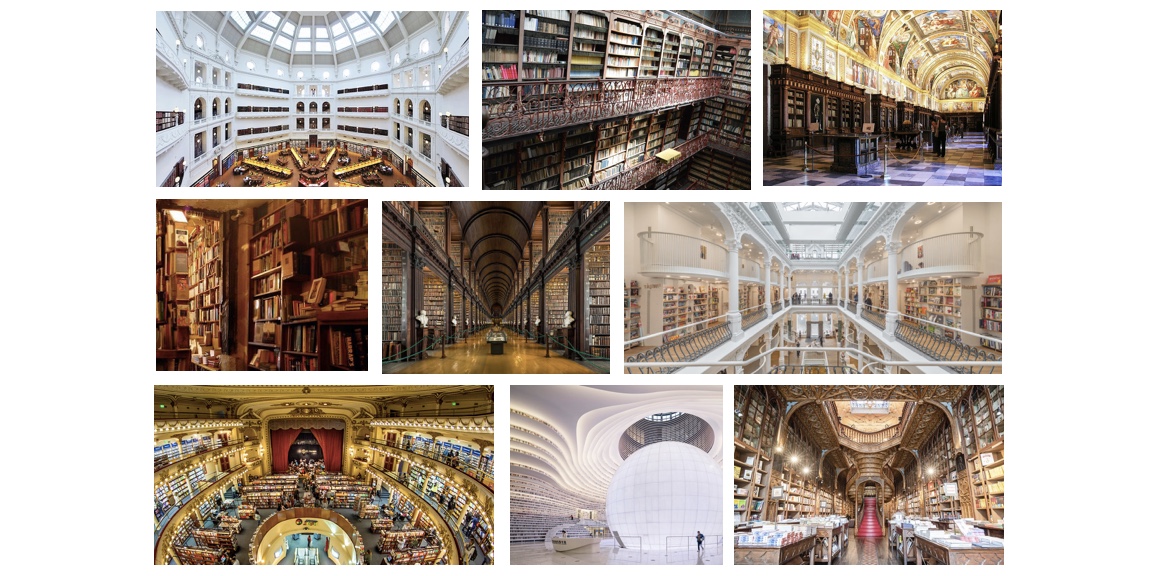For World Book Day on 23rd April, my students are working on very short videos showcasing unique libraries and bookshops around the world. Once they are edited, QR codes for each video will be displayed around the playground for students to watch them and look for specific information about each of them.

1. After explaining the goals of the project, I used wheelofnames.com to assign one library or bookshop to pairs of students. As simple as cutting and pasting the list below!
Tianjin Binhai Library (Tianjin, China)
The Joe and Rika Mansueto Library (Chicago, USA)
Stuttgart City Library (Stuttgart, Germany)
Trinity College Long Room (Dublin, Ireland)
Boston Public Library (Boston, USA)
Epos (Norway)
The Library of Alexandria (Alexandria, Egypt)
Royal Library (El Escorial, Spain)
Royal Portuguese Cabinet of Reading (Rio de Janeiro, Brazil)
Bodleian Library (Oxford, UK)
Biblioteca Vasconcelos (Mexico City, Mexico)
Beitou Public Library (Taipei, Taiwan)
Handelingenkamer Library (The Hague, Netherlands)
State Library Victoria (Melbourne, Australia)
Livraria Lello (Porto, Portugal)
Cărturești Carusel (Bucharest, Romania)
El Ateneo (Buenos Aires, Argentina)
Boekhandel Dominicanen (Maastricht, Netherlands)
The Bookworm (Beijing, China)
Libreria Acqua Alta (Venice, Italy)
Shakespeare & Co. (Paris, France)
Cafebrería El Péndulo (Mexico City, Mexico)
Oodi Central Library (Helsinki, Finland)
Duchess Anna Amalia Library (Weimar, Germany)
Biblioteca Statale di Lucca (Lucca, Italy)
The Black Diamond, Royal Danish Library (Copenhaguen, Denmark)

2. Before starting their research, I told the students their videos should be around 30 seconds long. We revised the differences between synthesising and summarising information, and the need to identify key points in each source, differentiate main ideas from details, or distinguish facts and opinions.
3. To help them through the planning process, I suggested following this basic structure:
- Name of the library or bookshop, city, country.
- When was it built?
- What makes it so special? Include at least three distinctive features.
- Think of a powerful closing sentence for your video.
4. Students started researching and selecting information in class, they looked for sources of public domain pictures and/or videos they could use, and they planned how they wanted to create the video, including their roles and responsibilities. With so many months of distance/blended/hybrid learning under their belts, it should have come as no surprise when they found tons of different (and tech-savvy!) options in a few minutes!

5. The students are sending their videos through our LMS. I will be holding conferences with each pair to go over their work and check what may need improving. I know the videos will be fine content-wise, and the students know we will be focusing on accuracy and intelligibility (and that they might need to make slight – or major – changes after the conference!) The students have also been asked to write two questions they would ask about their library or bookshop.
6. I will be uploading the final videos to the media site of our LMS and will create a QR code for each of them (qrcode-monkey.com/). These will be printed out and displayed outdoors on the school premises so that students can use their mobile phones to watch each video and answer the questions in the worksheet(s) I will be writing (using a selection of questions they have submitted.) The activity can be easily adpated to any level, so other groups of students will be invited to take this virtual tour around these fascinating bookshops and libraries as they practise a variety of listening comprehension skills.

By the way, would you add any other library or bookshop to the list?


How about Oodi library in Helsinki. It was the nation’s gift to the people of Finland when it celebrated its centenary of independence in 2017.
LikeLiked by 1 person
Added to the list! Thanks!
LikeLike
Reblogged this on news, articles, videos, vocabulary expansion, grammar clarification news, articles, etc. in English and commented:
I think this is a brilliant idea and it would be wonderful if lots of English teachers -and particularly those who currently are or have been with me at any time do it
LikeLike
https://www.bibliotecastatalelucca-bslu.beniculturali.it
You might like to add this very old library in Lucca, Tuscany is beautiful and when I once visited the chief librarian was incredibly welcoming and gave me a personal tour.
LikeLiked by 1 person
Thank you! Will do!
LikeLike
What about adding The Black Diamond – Royal Danish Library?
LikeLike
What about the New York Public Library?
LikeLiked by 1 person
Great idea! Thanks!
LikeLike
Georgetown University has a beautiful library called “Riggs Library.”
LikeLiked by 1 person
I’ve just checked it – it’s amazing! I’ve never been to Washington DC… Now I have some extra motivation. 🙂
Thanks for sharing this!
LikeLike
Unfortunately, because it’s not used as a library anymore, the doors are usually locked, so you can only peek in – unless you sign up for an event there, like a guest speaker.
LikeLike
I’ve done something similar by having students research different museums that have online virtual tours. When we were all online and could not take field trips, it was a good substitute. Each student did the research on one museum and presented it to the rest of the class.
LikeLiked by 1 person
Reblogged this on More than Teaching.
LikeLike